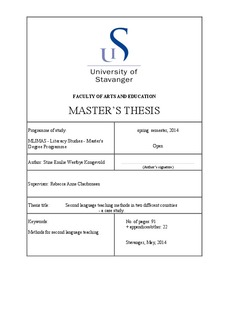| dc.description.abstract | In order for a minority student to function in the regular classroom, changes have been made to the way teaching a second language was conducted in America. These changes included the manifestation of English as a second language (ESL) standards that had to be reflected in the school’s ESL curriculum. Complementing this, in order to improve second language teaching, the Norwegian school system had to make changes to the politics regarding school and the way it includes students with diverse backgrounds, after experiencing an increase in the number of minority students attending Norwegian schools. Based on this, both America and Norway are countries with great experience within the field of second language teaching and were chosen as target countries for this thesis of which the main topic is methods for teaching a second language.
As the schools that are representing the two countries in this thesis present the use of two different teaching models, the theory behind the two different models will be presented. In addition, social factors and individual factors that can influence the student’s level of success in the target language will also serve as important theories for this thesis.
The purpose of this study was to gain insight into how these two teaching models were used and supported by different teaching methods. Also, the teachers and students were invited to share their opinions regarding the teaching methods used at their schools.
Based on the topic, the following research questions are addressed within this thesis:
1. What second language teaching models are used in two different countries?
2. What are the teachers’ opinions and feelings regarding advantages and disadvantages within the teaching models used at their schools?
3. What are the students’ opinions and experiences with the teaching methods used during teaching at their schools?
4. What factors, both individual and social, are the students affected by while learning their second language?
A qualitative approach was used during the research period for this thesis. Interviews with both English as a second language (ESL) teachers and Norwegian as a second language (NL2) teachers were conducted, in addition to interviews with students from both schools. A total of 6 teachers and 10 students were interviewed. Complementing the interviews, observations of multiple ESL and NL2 lessons were also conducted. The results of the interviews were compared between the schools and discussed in light of the theory.
Through the research it was confirmed that the two target schools used two different approaches for teaching a second language, and the teachers presented varied advantages and disadvantages associated with the two models. The students presented various answers to the questions during the interviews, relating to the fact that they were part in different teaching models. Also, the two student groups were influenced by different social and individual factors. The outcome of the research led to the conclusion that the Norwegian school might benefit from trying a teaching method more similar to the one used in the American school. Based on the disadvantages presented by the NL2 teachers, the current approach to second language teaching was not beneficial enough for their school. However, the factors influencing the students outside of school led to a higher level of skill amongst the NL2 students than the ESL students, regardless of the fact that they were part in a less effective teaching model.
The significance of the outcome is considerable as the teaching model described in the ESL context could solve many of the problems the NL2 teachers had with their current teaching method. The results of this thesis could contribute to further studies of implementing the push-in teaching method to a Norwegian school. However, there are some implications as only one Norwegian school was the subject of this thesis, and the results are therefore a reflection of that particular school, and not all Norwegian schools in general. Additionally this can also be said of the school in the states, as the researcher does not have information on ESL teaching in other schools. | nb_NO |
